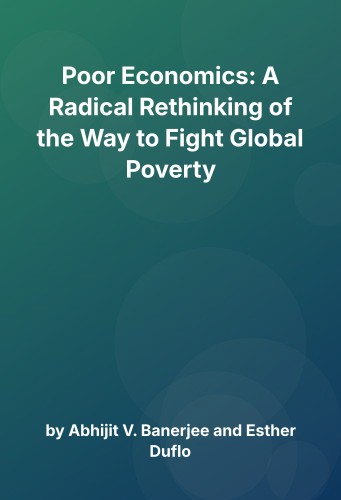Introduction
“Poor Economics” by Abhijit V. Banerjee and Esther Duflo examines the nuanced realities of poverty and proposes a systematic and evidence-based approach to understanding and alleviating global poverty. Through a series of field studies and experiments, the authors challenge conventional wisdom and offer fresh insights into the behaviors, challenges, and decisions faced by the world’s poor.
Core Frameworks and Concepts
At the heart of “Poor Economics” is a framework that emphasizes a deep understanding of the economic behaviors of the poor, drawn from empirical research and randomized control trials. The authors suggest a microeconomic approach to poverty alleviation, focusing on the following key components:
1. Understanding the Decision-Making Process of the Poor
Banerjee and Duflo argue that the poor are not fundamentally different from the wealthier segments of society; rather, they face a different set of constraints. The book explores how limited resources and unpredictable environments affect their choices.
Example: Consider the choice between spending on education or healthcare. A poor family may prioritize immediate health needs over long-term educational benefits due to the immediate threat of illness.
2. Identifying Effective Interventions
The authors advocate for interventions grounded in empirical evidence, highlighting the importance of testing policies to determine their efficacy before scaling them up.
Example: They discuss how small changes, such as providing free school uniforms, can significantly increase school attendance rates, drawing parallels with insights from “The White Man’s Burden” by William Easterly, which critiques large-scale development projects lacking localized understanding.
3. The Role of Incentives
Banerjee and Duflo examine how incentives can drive behavior change. They compare various incentive structures and their impact on outcomes, similar to the discussions in “Nudge” by Richard Thaler and Cass Sunstein, which emphasizes behavioral economics in policy design.
Example: Financial incentives for vaccination can lead to better health outcomes by making it easier for families to access medical care.
4. The Importance of Local Knowledge
Understanding local contexts and involving community members in the design and implementation of policies are critical steps.
Example: Microfinance institutions often succeed because they tailor their products to the specific needs and repayment capacities of local communities, echoing themes from “The Fortune at the Bottom of the Pyramid” by C.K. Prahalad.
5. Tackling the Most Pressing Needs First
The authors suggest prioritizing interventions that address the most urgent needs, such as health, education, and financial access.
Example: Initiatives that provide clean water and sanitation can have a broad impact on health, productivity, and education, creating a ripple effect of positive change.
Key Themes
1. The Complexity of Economic Behavior
The book delves into the multifaceted nature of economic behavior among the poor, emphasizing that poverty is not merely a lack of income but a complex web of challenges.
2. The Limitations of Traditional Economic Models
Banerjee and Duflo critique traditional economic models that oversimplify the experiences of the poor. They argue for more nuanced models that capture the realities of living in poverty.
3. The Power of Small Changes
The authors demonstrate how small, context-specific changes can significantly improve the lives of the poor, highlighting the importance of incremental progress.
4. The Role of Evidence-Based Policy
“Poor Economics” advocates for policies based on rigorous research and data analysis, underscoring the value of randomized controlled trials in development economics.
5. Rethinking Global Aid
The book challenges the effectiveness of traditional aid approaches and calls for more innovative and flexible strategies that adapt to changing circumstances and local needs.
Final Reflection
“Poor Economics” offers a transformative perspective on global poverty, urging policymakers, researchers, and practitioners to embrace a more nuanced and evidence-driven approach. By synthesizing insights from behavioral economics, development studies, and field research, Banerjee and Duflo provide a roadmap for creating more effective and sustainable poverty alleviation strategies.
This book stands alongside “The End of Poverty” by Jeffrey Sachs and “Development as Freedom” by Amartya Sen, enriching the discourse on global development by emphasizing the importance of understanding the unique contexts and behaviors of those living in poverty. Its lessons resonate across domains, influencing how we think about leadership, policy design, and change management in various fields.
This expanded overview provides a comprehensive understanding of the book’s themes and contributions to the field of development economics, while integrating insights from related works to offer a well-rounded perspective.

